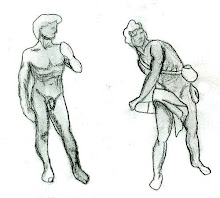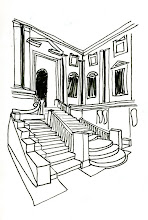
periphery:
Much like last weeks word boundary, periphery is a line that forms a perimeter or boundary of an area. As suggested by answers.com. In Roth’s, (2007) understanding architecture one could find “The old structure was gutted and offices and gallery space constructed around its periphery opening up a large atrium in the center of the building.” (p. 509) This last statement was speaking about the remodeling of Piazza D’ Italia by designer Charles Moore.
When I read this segment of the book it reminded me of the Atrium we have here on UNC-G’s campus. Now I finally know why it’s called the Atrium. The word periphery reminds me of peripheral vision which is why I chose to draw an underwater seen. Most fish shear a peripheral vision unlike that of the humans.
portfolio:
During the Renaissance period there had been quite a few political outbreaks in Italy it was because of this that many architects and artists sought for work in other countries. Roth, (2007) “ The Best known of these artists was Leonardo de Vinci, who was supported by Francis I in his late years, but among the architects who moved to France was Serlio who was commissioned to work on the royal chateau Fontainebleau and who published several of his volumes in France.” (p.315) During this time de Vinci had built up his portfolio.
I had chosen to draw my portfolio here at studio.

process:
Process is the steps taken to complete a project whether it is a story or a design. Every design has its own story and every story its own design. In a story there is a beginning, middle, climax, and end. The beginning consists of getting all the parts and charters together. The middle supplies a more in-depth thought process. The climax is the most exciting part of the story where the most drama or action takes place. And the end is where the story either comes to a conclusive stop or a screeching halt.
And the same can be said for design, of course with a few minor adjustments. The beginning is where all the thoughts and research take place. The middle is where the thoughts and ideas come together and start to move, while gaining momentum, toward one idea or train of thought. The climax is that eureka moment where the designer has reached an even better idea then they thought they could. And the end is when the project is either finished or about to take a new turn in starting over.
The reason I chose to draw lace is because in one area of Italy lace was so highly thought of, used, and produced that the Italian’s actually incorporated it into the facade of their architecture. This is a perfect example of process because in their design process they not only incorporated materials from the local area but also the latest fashion.
perspective:
Perception is the way one perceives or actually physically sees an object. I have chosen to draw a two point perspective of the Villa Rotunda. This building is located in Italy and it is special because instead of one façade it has four. The building is also a great plan example of a circle square structured ceiling.
This week in art history we learned that upper class Italian families usually had homes which consisted of three different levels. The first being open to the public and specifically used for holding business meetings; the second level was for close social gatherings; and the third was for family only. This layout is professional in the way that there are different areas that satisfy different needs of the family.
Also professionalism can be linked to our other vocabulary word- portfolio. Just this past week we had a portfolio review where we needed all of our projects to be presented in an organized thought-out manor. The students with the best grade got their high score purely by their professionalism.
http://www.answers.com/topic/periphery
Also professionalism can be linked to our other vocabulary word- portfolio. Just this past week we had a portfolio review where we needed all of our projects to be presented in an organized thought-out manor. The students with the best grade got their high score purely by their professionalism.
http://www.answers.com/topic/periphery












No comments:
Post a Comment